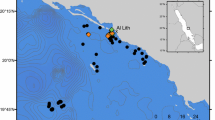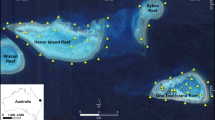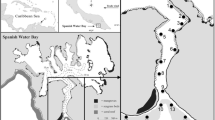Abstract
Little information is available on the movements and behaviour of tropical rays despite their potential ecological roles and economic value as a fishery and a tourism resource. A description of the movement patterns and site fidelity of juvenile rays within a coral reef environment is provided in this study. Acoustic telemetry was used to focus on the use of potential nursery areas and describe movement patterns of 16 individuals of four species monitored for 1–21 months within an array of 51 listening stations deployed across a lagoon, reef crest, and reef slope at Mangrove Bay, Ningaloo Reef, Western Australia. Juveniles used a small (< 1 km2), shallow (1–2 m depth) embayment where three receivers recorded 60–80 % of total detections of tagged animals, although individuals of all species moved throughout the array and beyond the lagoon to the open reef slope. Detections at these primary sites were more frequent during winter and when water temperatures were highest during the day. Long-term use of coastal lagoons by juvenile rays suggests that they provide an important habitat for this life stage. Current marine park zoning appears to provide an effective protection for juveniles within this area.




Similar content being viewed by others
References
Ache de Freitas RH, Rosa RS, Wetherbee BM, Gruber SH (2009) Population size and survivorship for juvenile lemon sharks (Negaprion brevirostris) on their nursery grounds at marine protected area in Brazil. Neotropical Ichthyol 7:205–212
Ackerman JT, Kondratieff MC, Matern SA, Cech JJ (2000) Tidal influence on spatial dynamics of leopard sharks, Triakis semifasciata in Tomales Bay, California. Environ Biol Fishes 58:33–43
Bates DM, Sarkar D (2007) lme4: Linear mixed-effects models using S4 classes, R package version 0.99875-6
Branstetter S (1990) Life style of sharks. In: Gruber SH (ed) One reason sharks are vulnerable to overfishing, a volume honoring the work of Stewart Springer. American Litoral Society Highlands, New Jersey, pp 23–29
Burnham KP, Anderson DR (2002) Model selection and multimodel Inference: a practical information-theoretic approach. Springer, New York
Castro JI (1993) The shark nursery of Bulls Bay, South Carolina, with a review of the shark nurseries of the southeastern coast of the United States. Environ Biol Fishes 38:37–48
Cerutti-Pereyra F, Meekan MG, Wei N-WV, O’Shea O, Bradshaw CJA, Austin CM (2012) Identification of Rays through DNA Barcoding: An Application for Ecologists. PLoS One 7:e36479
Chapman DD, Babcock EA, Gruber SH, Dibattista JD, Franks BR, Kessel SA, Guttridge T, Pikitch EK, Feldheim KA (2009) Long-term natal site-fidelity by immature lemon sharks (Negaprion brevirostris) at a subtropical island. Mol Ecol 18:3500–3507
Collins A, Heupel MR, Motta PJ (2007) Residence and movement patterns of cownose rays Rhinoptera bonasus within a south-west Florida estuary. J Fish Biol 71:1159–1178
Conrath CL (2008) Investigations into depth and temperature habitat utilization and overwintering grounds of juvenile sandbar sharks, Carcharhinus plumbeus: the importance of near shore North Carolina waters. Environ Biol Fishes 82:123–131
Dale JJ, Wallsgrove NJ, Popp BN, Holland K (2011) Nursery habitat use and foraging ecology of the brown stingray Dasyatis lata determined from stomach contents, bulk and amino acid stable isotopes. Mar Ecol Prog Ser 433:221–236
Dames L, Moore (2000) Ningaloo Marine Park (Commonwealth Waters) Literature review
DeAngelis BM (2008) First characterization of shark nursery habitat in the United States Virgin Islands: evidence of habitat partitioning by two shark species. Mar Ecol Prog Ser 358:257–271
Department of Conservation and Land Management (2005) Management plan for the Ningaloo Marine Park and Muiron Islands Marine Management Area 2005–2015. Management Plan no. 52. Department of Conservation and Land Management, Perth
Dewar H, Mous P, Domenier M, Muljadi A, Pet J, Whitty J (2008) Movements and site fidelity of the giant manta ray, Manta birostris, in the Komodo Marine Park, Indonesia. Mar Biol 151:121–133
Di Santo V, Bennett WA (2011) Is post-feeding thermotaxis advantageous in elasmobranch fishes? J Fish Biol 78:195–207
DiGirolamo AL, Gruber SH, Pomory C, Bennett WA (2012) Diel temperature patterns of juvenile lemon sharks Negaprion brevirostris, in a shallow-water nursery. J Fish Biol 80:1436–1448
Dulvy NK, Reynolds JD (2002) Predicting extinction vulnerability in skates. Predicción de la vulnerabilidad de extinción en rayas. Conserv Biol 16:440–450
Dulvy NK, Metcalfe JD, Glanville J, Pawson MG, Reynolds JD (2000) Fishery stability, local extinctions, and shifts in community structure in skates. Estabilidad de la pesquería, extinciones locales y cambios en la estructura de comunidades de rayas. Conserv Biol 14:283–293
Economakis AE, Lobel PS (1998) Aggregation behavior of the gray reef shark, Carcharhinus amblyrhynchos, at Johnston Atoll, central Pacific Ocean. Environ Biol Fishes 51:129–139
Fangue NA, Bennett WA, Douglas ME (2003) Thermal tolerance responses of laboratory-acclimated and seasonally acclimatized Atlantic stingray, Dasyatis sabina. Copeia 2003:315–325
Frisk MG (2010) Life history strategies of Batoids. In: Carrier JC, Musick JA, Heithaus MR (eds) The Biology of Sharks and their Relatives. CRC Press, Boca Raton, pp 283–316
Garla RC, Chapman DD, Shivji MS, Wetherbee BM, Amorim AF (2006a) Habitat of juvenile Caribbean reef sharks, Carcharhinus perezi, at two oceanic insular marine protected areas in the southwestern Atlantic Ocean: Fernando de Noronha Archipelago and Atol das Rocas, Brazil. Fish Res 81:236–241
Garla RC, Chapman DD, Wetherbee BM, Shivji M (2006b) Movement patterns of young Caribbean reef sharks, Carcharhinus perezii, at Fernando de Noronha Archipelago, Brazil: the potential of marine protected areas for conservation of a nursery ground. Mar Biol 149:189–199
Grubbs RD, Musick JA, Conrath CL, Romine JG (2005) Long-term movements, migration and temporal delineation of a summer nursery for juvenile sandbar sharks in the Chesapeake Bay Region. American Fisheries Society Symposium:1–22
Heupel M (2007) Exiting Terra Ceia Bay: an examination of cues stimulating migration from a summer nursery area. Am Fish Soc Symp 50:265–280
Heupel M, Heuter R (2001) Use of a remote acoustic telemetry system to monitor shark movements in a coastal nursery area. In: Sibert JR, Nielsen JL (eds) Electronic Tagging and Tracking in Marine Fisheries. Kluwer Academic Publishers, Amsterdam, pp 217–223
Heupel M, Simpfendorfer CA, Hueter RE (2004) Estimation of shark home ranges using passive monitoring techniques. Environ Biol Fishes 71:135–142
Heupel M, Simpfendorfer CA, Collins AB, Tyminski JP (2006) Residency and movement patterns of bonnethead sharks, Sphyrna tiburo, in a large Florida estuary. Environ Biol Fishes 76:47–67
Heupel MR, Carslon JK, Simpfendorfer C (2007) Shark nursery areas: concepts, definition, characterization and assumptions. Mar Ecol Prog Ser 337:287–297
Hight BV, Lowe CG (2007) Elevated body temperatures of adult female leopard sharks, Triakis semifasciata, while aggregating in shallow nearshore embayments: Evidence for behavioral thermoregulation? J Exp Mar Biol Ecol 352:114–128
Holland KN, Wheatherbee BM, Peterson JD, Lowe CG (1993) Movements and distribution of hammerhead shark pups on their natal ground. Copeia 1993:495–502
Hopkins TE, Cech JJ Jr (2003) The influence of environmental variables on the distribution and abundance of three elasmobranchs in Tomales Bay. Calif Environ Biol Fish 66:279–291
Huveneers C, Harcourt R, Boomer A, Hobday AJ, Pederson H, Semmens JM, Stieglitz T, Vallee R, Webber D, Heupel M, Simpfendorfer C, Peddemors V (2009) The influence of environmental parameters (meteorological and oceanographic) on the performance of acoustic receivers. Papers from 2nd AATAMS Workshop AATAMS Workshop, Mosman, NSW, Australia
Kinney MJ, Simpfendorfer CA (2009) Reassessing the value of nursery areas to shark conservation and management. Conserv Lett 2:53–60
Klimley AP, Kihslinger RL, Kelly JT (2005) Directional and non-directional Movements of bat rays, Myliobatis californica, in Tomales Bay, California. Environ Biol Fishes 74:79–88
Last P, Stevens J (2009) Sharks and Rays of Australia, 2nd edn. CSIRO, Collingwood
Marshall AD, Kyne PM, Bennett MB (2008) Comparing the diet of two sympatric urolophid elasmobranchs (Trygonoptera testacea Muller & Henle and Urolophus kapalensis Yearsley & Last): evidence of ontogenetic shifts and possible resource partitioning. J Fish Biol 72:883–898
Matern SA, Cech JJ, Hopkins TE (2000) Diel movements of bat rays, Myliobatis californica, in Tomales Bay, California: evidence for behavioral thermoregulation? Environ Biol Fishes 58:173–182
MATLAB (2010) MathWorks, Natick, Massachusetts, USA, http://www.mathworks.com/products/matlab/
Medved RJ, Marshall JA (1983) Short-term movements of young sandbar sharks Carcharhinus plumbeus (Pisces, Carcharhinidae). Bull Mar Sci 33:87–93
Meyer CG, Clark TB, Papastamatiou YP, Whitey NM, Holland KN (2009) Long-term movement patterns of tiger sharks Galeocerdo cuvier in Hawaii. Mar Ecol Prog Ser 381:223–235
Morrisey JF, Gruber SH (1993) Habitat selection by juvenile lemon sharks, Negaprion brevirostris. Environ Biol Fishes 38:311–319
O’Shea OR, Thums M, van Keulen M, Meekan M (2012) Bioturbation by stingrays at Ningaloo Reef, Western Australia. Mar Freshw Res 63:189–197
Papastamatiou YP, Lowe CG, Caselle JE, Friedlander AM (2009) Scale-dependent effects of habitat on movements and path structure of reef sharks at a predator-dominated atoll. Ecol Soc 90:996–1008
Payne NL, Gillanders BM, Webber DM, Semmens JM (2010) Interpreting diel activity patterns from acoustic telemetry: the need for controls. Mar Ecol Prog Ser 419:295–301
Pinheiro J, Bates D, DebRoy S, Sarkar D, the R Development Core Team (2011) nlme: linear and nonlinear mixed effects models. R package version 3.1-101.
R Development Core Team (2011) R: A language and environment for statistical computing. R Foundation for Statistical Computing, Vienna
Romanov EV (2001) Bycatch in the tuna purse-seine fishery in the western Indian Ocean. Fish Bull 100:90
Rousset J (1990) Population structure of thornback rays Raja clavata and their movements in the Bay of Douarnenez. J Mar Biol Assoc UK 70:261–268
Simpfendorfer CA, Heupel M (2004) Assessing habitat use and movement. In: Carrier JC, Musick JA, Heithaus MR (eds) Biology of Sharks and their Relatives. CRC Press, Boca Raton, pp 533–571
Sims DW, Wearmouth VJ, Southall EJ, Hill JM, Moore P, Rawlinson K, Hutchinson N, Budd GC, Righton D, Metcalfe JD, Nash JP, Morritt D (2006) Hunt warm, rest cool: bioenergetic strategy underlying diel vertical migration of a benthic shark. J Anim Ecol 75:176–190
Speed CW, Field I, Meekan MG, Bradshaw CJA (2010) Complexities of coastal shark movements and their implications for management. Mar Ecol Prog Ser 408:275–293
Springer S (1960) Natural history of the sandbar shark, Eulamia milberti. Fish Bull 61:1–38
Stevens J (2002) A review of Australian elasmobranch fisheries. Pages 122–126 in Elasmobranch, biodiversity, conservation and management: Proceedings of the international seminar and workshop. IUCN SSC Shark Specialist Group. IUCN, Gland and Cambridge, Sabah, Malayisia, July 1997
Stevens J, Last PR, White WT, McAuley RB, Meekan MG (2009) Diversity, abundance and habitat utilization of sharks and rays. Final report to Western Australian Marine Science Institute. CSIRO
Vaudo J, Heithaus M (2009) Spatiotemporal variability in a sandflat elasmobranch fauna in Shark Bay, Australia. Mar Biol 156:2579–2590
Vaudo JJ, Lowe CG (2006) Movement patterns of the round stingray Urobatis halleri (Cooper) near a thermal outfall. J Fish Biol 68:1756–1766
Ward RD, Hanner R, Hebert PDN (2009) The campaign to DNA barcode all fishes, FISH-BOL. J Fish Biol 74:329–356
Yeiser BG, Heupel MR, Simpfendorfer CA (2008) Occurrence, home range and movement patterns of juvenile bullshark (Carcharhinus leucas) and lemon (Negaprion brevirostris) sharks within a Florida estuary. Mar Freshw Res 59:489–501
Yokota L, Lessa R (2006) A nursery area for sharks and rays in northeastern Brazil. Environ Biol Fishes 75:349–360
Acknowledgments
This research was approved by the Animal Ethics Committee from Charles Darwin University (no. A07026). We thank to the Australian Institute of Marine Science (AIMS) and CSIRO for financially supporting this project, and CONACYT-Mexico for international grant. We thank the tagging and receiver-deployment crews, P. Last for species identification, Y. Berger for analytical assistance, D. Lindsay for comments on the manuscript, A. Tan and D. McGaffin for tagging and sampling equipment manufacture, and C. Speed, F. McGregor, S. Baccarella, K. Wenziker, P. Haskell, Exmouth Light Engineering and Ningaloo Dreaming for field assistance.
Author information
Authors and Affiliations
Corresponding author
Electronic supplementary material
Below is the link to the electronic supplementary material.
Fig. S1
Mangrove Bay array range testing. Proportion of detections received by VR2 receivers at increasing distances from the test transmitter in the lagoon channel (filled circles, 4 m water depth) and at Mangrove Bay (white circles, 1 m water depth) (DOC 446 kb)
Fig. S2
Proportion of days spent by each species inside and outside of the Mangrove Bay sanctuary zone (DOC 190 kb)
Fig. S3
Number of daily detections per ray at Mangrove Bay. Individual plots of detections of juvenile rays primary receives (solid shapes) and other receivers (hollow shapes). (DOC 725 kb)
Rights and permissions
About this article
Cite this article
Cerutti-Pereyra, F., Thums, M., Austin, C.M. et al. Restricted movements of juvenile rays in the lagoon of Ningaloo Reef, Western Australia – evidence for the existence of a nursery. Environ Biol Fish 97, 371–383 (2014). https://doi.org/10.1007/s10641-013-0158-y
Received:
Accepted:
Published:
Issue Date:
DOI: https://doi.org/10.1007/s10641-013-0158-y




